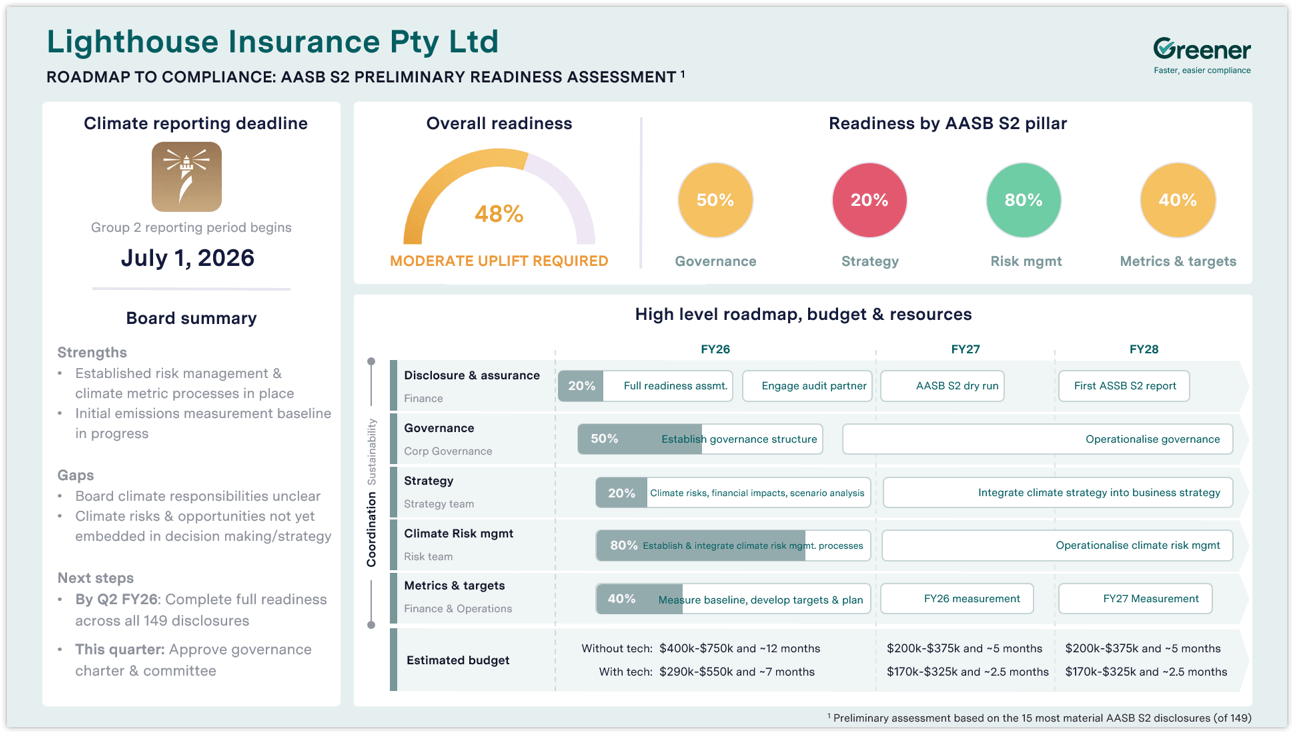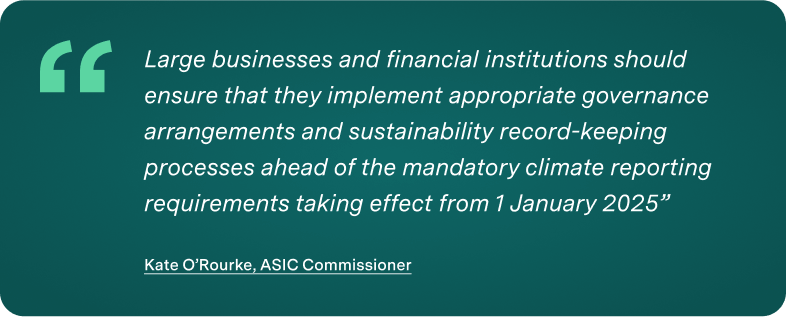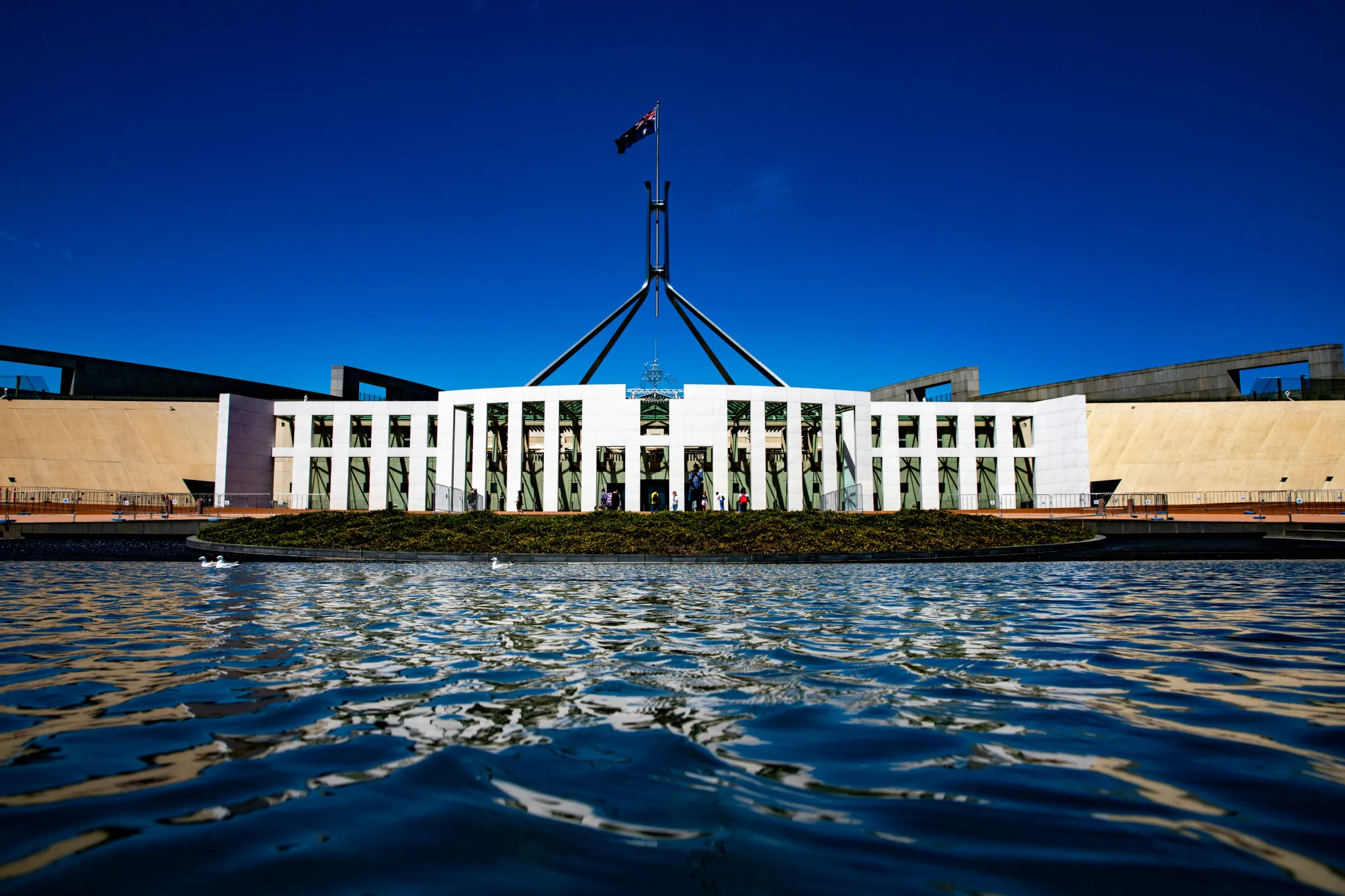What is a Readiness Assessment, and why now?
Don’t know where to start with Australia’s Sustainability Reporting Standard (ASRS) AASB S2?
A readiness assessment is your compliance health check for mandatory climate reporting. It maps your current capabilities against AASB S2 requirements and gives you a clear roadmap - covering resourcing, systems and budget. In plain terms, it shows you where the gaps are in governance, data, risk management and reporting before they could expose you to penalties. The upper end of the spectrum for false or misleading statements, potentially resulting up to $16.5 million or 10% of annual turnover.
And the risk is real. ASIC fined Vanguard $12.9 million, Mercer $11.3m, and Active Super $10.5m in 2025 for misleading claims.
An AASB S2 readiness assessment also clarifies whether you need systems, consultants, or both. For most Group 2 and 3 organisations, a hybrid approach is the most cost-effective, keeping budgets tight and audits smooth to avoid expensive remediation when deadlines hit.
Why now?
Group 2 entities begin reporting from 1 July 2026 (less than 10 months away) and Group 3 follow soon after with just 22 months to build systems, governance, and emissions measurement from the ground up.
Starting now turns what could be a 12-month scramble into a strategic plan, saving hundreds of thousands in consultant fees, system rework and audit overruns - while putting you ahead of competitors still trying to decode AASB S2.
Not sure what Group your business falls in? See the Preliminary readiness assessment toolkit below.
Why conducting a Readiness Assessment matters for your business
Picture your next board meeting: "Are we ready for mandatory climate reporting?".
The room falls silent, and all eyes turn to you.
Without a readiness assessment and roadmap to AASB S2 compliance, businesses risk chasing the wrong priorities - wasting months and potentially hundreds of thousands on misaligned solutions. Worse still, breaches of corporate law could see directors personally liable, including prison terms.
A readiness assessment isn’t a box-ticking exercise. It’s your business case for resources, your insurance against failure, and your pathway to building lasting capability.
The benefits of acting now are quantifiable, with unprepared companies facing
- Emergency consultant and assurance fees often double standard rates
- Failed first attempts that need costly rework, usually when time has already run out
- Extended audit timelines when under ASIC deadline pressure
ASIC Commissioner Kate O’Rourke has already warned entities to implement strong governance and sustainability record-keeping processes now, highlighting the far-reaching impact of this reform.
Meanwhile, prepared companies secure better terms with service providers, build capabilities that serve beyond compliance, and position themselves as leaders with investors and customers.
The assessment also reveals unexpected benefits: operational efficiencies through better data, enhanced risk management frameworks, and strategic insights about climate opportunities previously invisible.

The practical guide to Readiness: who needs to do what, by when
What AASB S2 actually requires
AASB S2 requires disclosure of climate-related risks and opportunities affecting cash flows, access to finance or cost of capital. These disclosures must be reported with the same rigour as financial reporting.
Main requirements relate to governance, strategy, risk management, and metrics and targets, including scenario analysis and Scope 1, 2 and 3 emissions. Your readiness assessment must evaluate capabilities across all four AASB S2 pillars:
- Governance: Board oversight mechanisms and management accountability structures
- Strategy: Climate scenario analysis capability and financial impact quantification
- Risk Management: Integration with enterprise risk frameworks
- Metrics & Targets: Emissions measurement systems with audit trails

The high-level, step by step guide
To make it easy for you, here’s the 6 step process to undertake a Readiness Assessment, outlining who needs to do what.
Considering Group 2 entities have <10 months to start reporting (and <22 months for Group 3), regardless of what Group you’re in, the when for these activities is now.
The key is starting early enough to address gaps systematically rather than in crisis mode.
Step 1: Mobilise your cross-functional assessment team
- Who: CFO leads, with Risk, Sustainability, Operations, HR and IT
- When: Immediately (week 1)
- How:
- Appoint executive sponsor with board reporting line
- Identify subject matter experts across functions
- Establish weekly steering committee
- Output: Project charter with clear accountabilities
Step 2: Map current state against requirements
- Who: Cross-functional assessment team
- When: Week 2
- How:
- Use AASB S2 requirements checklist (220+ items)
- Document existing policies, systems and data
- Identify what's missing, partial or complete
- Output: Board-approved climate governance charter
Step 3: Assess data and systems readiness
- Who: Finance, IT and Operations teams
- When: Week 2
- How:
- Inventory current emissions data sources
- Test data quality and audit trails
- Evaluate system integration needs
- Output: Data maturity assessment and system requirements
Step 4: Evaluate governance and capability
- Who: Company Secretary and HR
- When: Week 3
- How:
- Review board and management structures
- Assess climate expertise gaps
- Survey stakeholder understanding
- Output: Governance gap analysis and capability plan
Step 5: Define your resource needs
- Who: CFO with department heads
- When: Week 3
- How:
- Estimate internal FTE requirements
- Identify technology investments needed
- Calculate external support costs
- Output: Resource plan with budget estimates
Step 6: Build your compliance roadmap
- Who: Executive team
- When: Week 4
- How:
- Prioritise gaps by risk and effort
- Sequence initiatives over 12-18 months
- Define success metrics and milestones
- Output: Board-ready roadmap with investment case


Common mistakes to avoid
Mistake #1: Treating readiness assessment as a box-ticking exercise
Rushing through compliance formality, businesses can end up with shallow outputs that satisfy initial disclosure requirements, but need to be reworked and miss strategic value.
Do instead: Use it as strategic planning that identifies opportunities. 80% of directors that see climate as material risk also see opportunity.
Mistake #2: Excluding key functions from assessment
Limiting the process to finance or sustainability ignores critical dependencies across IT, HR, risk and operations - leading to blind spots across systems, data and controls.
Do instead: Involve finance, risk, operations, HR and IT from day one. Less than 60% have involved technology function in their mandatory climate reporting efforts despite planning to.
Mistake #3: Leaving it too late
AASB S2 compliance can take years, not weeks, and rushing means exposing your gaps to investors, auditors or strategic clients.
Do instead: Conduct your readiness assessment now. Use any available lead time to test systems, build processes, and ensure your first report is audit-ready to save on cost.
Quick wins
Quick win #1: Confirm your start date
Check if your business is captured by the legislation, and identify which rollout group you fall into (see the Preliminary readiness assessment toolkit below).
Result: Clarity on your reporting timelines.
Quick win #2: Conduct a preliminary readiness assessment
Get an early view of your compliance roadmap and key risks, along with indicative budget needs for planning (see the Preliminary readiness assessment toolkit below).
Result: An initial view on your roadmap to compliance and placeholder budget needs for your upcoming budget planning cycle.
Quick win #3: Proactively inform your board
Share your one-page preliminary readiness dashboard with the board to let them know you are proactively preparing for compliance, while embarking on your complete readiness assessment.
Result: Immediate board engagement and sponsorship

Toolkit: Preliminary readiness assessment
It takes less than 5 mins, and you get a high-level, board ready roadmap to AASB S2 compliance, that surfaces immediate gaps, risks and initial placeholders for budget season.
It’s low effort and high impact, designed to give Executives and Boards clarity while mobilising for the complete readiness journey across all 149 disclosures.
Walk into your next board meeting with confidence, knowing where you stand today and what to do next.
Disclaimer: This toolkit provides a preliminary snapshot, and should not be solely relied on for your AASB S2 report submission.


Next steps: Your 30 day action plan
ASIC urges all entities, including Groups 2 and 3, to begin preparing now - here's your action plan to get started.
Week 1: Mobilise & engage
- Use the preliminary readiness assessment tool to confirm which AASB S2 Group you’re in, and get an early view on your roadmap to compliance
- Use this to brief your Executive team on AASB S2 and form cross-functional assessment team
- Schedule board briefing on findings
Week 2: Assess
- Conduct workshops with each function
- Complete a detailed gap analysis against all AASB S2 disclosure requirements
- Interview key stakeholders on capabilities
Week 3: Analyse
- Prioritise gaps by risk and effort
- Develop preliminary resource & budget estimates
- Identify quick wins for immediate action
Week 4: Plan
- Create 18-month implementation roadmap
- Prepare board paper with investment case
- Establish governance structure
What’s after readiness?
With your readiness baseline established, Module 3 will guide you through building the governance framework essential for AASB S2 compliance (coming soon).

Additional resources
For those who want to dive deeper, here is some additional reading:
















